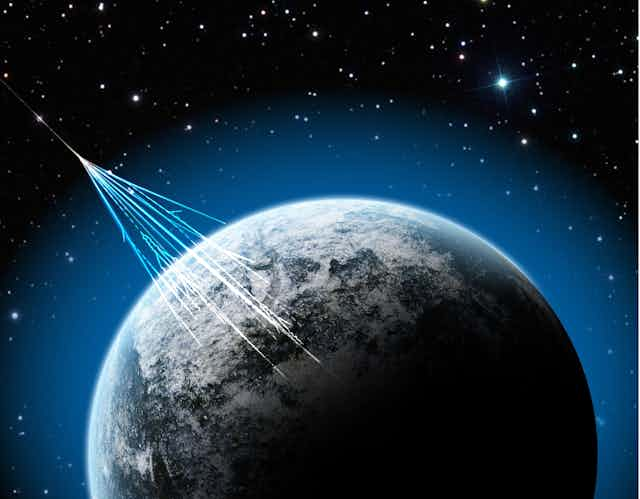Cosmic rays are subatomic particles of astrophysical origin that crash into our atmosphere, triggering a cascade of lower energy particles we can observe at the ground. And while astronomers have known of the existence of cosmic rays for more than a century, the key mystery – that of their origin – has yet to be solved.
Research published in Science today may help. We, along with colleagues in the international IceCube Collaboration, showed it’s possible to detect a previously missing counterpart to cosmic rays: astrophysical neutrinos.
The most energetic cosmic ray interactions we detect are more than a thousand times greater in energy than what the Large Hadron Collider (LHC) can produce.
Cosmic rays are charged particles, and as a result are deflected when they pass through the magnetic fields that pervade the cosmos. Because of this deflection, when a cosmic ray arrives at Earth its direction does not necessarily point back to its source.
Neutrinos are a bit different. They are nearly massless particles created in many particle interactions such as radioactive decay. They pass through most matter unnoticed, interacting only rarely, allowing them to travel great distances across the universe at the cost of being tricky to detect.
Astrophysical neutrinos are generally thought to appear wherever cosmic rays originate, and unlike gamma rays are a much less ambiguous signature of cosmic ray interactions. Most importantly neutrinos lack any charge, and hence always point back to their source.
The world’s strangest observatory
The IceCube Neutrino Observatory in Antarctica is a unique detector with the highest sensitivity to direct observations of astrophysical neutrinos of any detector in existence.
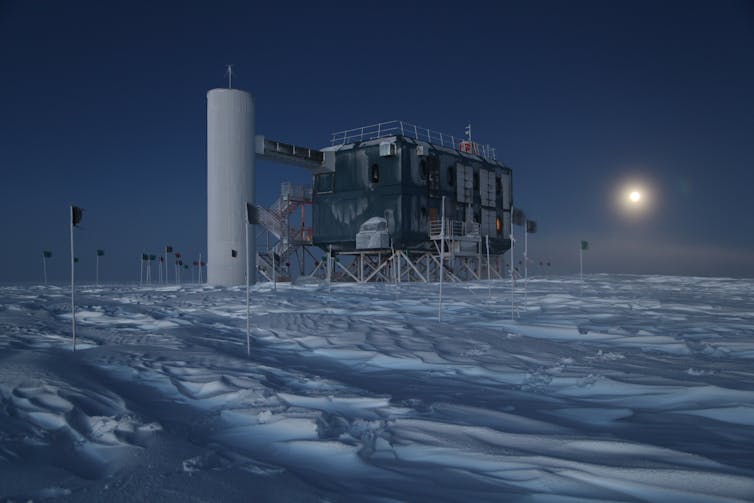
IceCube consists of more than 5,000 optical sensors buried between 1.5 and 2.5 kilometres down in the dark, clear ice beneath the Amundsen-Scott South Pole Station.
Together, the optical sensors can see light made anywhere in the cubic kilometre of instrumented ice. The job of the optical sensors is to detect the Cherenkov light made when charged particles move through the ice faster than the local speed of light.
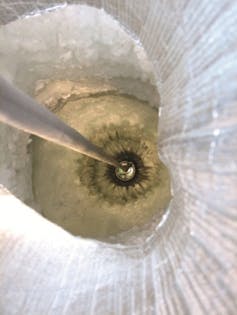
The only two types of particle capable of travelling from the Earth’s surface to the depth of IceCube are:
- muons (unstable subatomic particles) from cosmic ray air showers which make a streak of light through the detector
- neutrinos, which can interact with protons and neutrons in the ice and make a cascade of charged particles.
Smaller detectors (such as the 12m Sudbury Neutrino Observatory in Canada) see low energy neutrinos all the time from the sun. Neutrinos have also been seen briefly at these smaller detectors from the supernova SN1987A. Higher energy “atmospheric neutrinos” can come from the same cascades in the atmosphere made by cosmic rays.
IceCube has been able to see these atmospheric neutrinos since early in its construction by looking for muons, starting from below the detector travelling up towards the surface.
Such muons can only come from a neutrino interaction close to IceCube, as a muon can only travel a few kilometres before dying out. Neutrinos, on the other hand, can travel the whole breadth of the Earth without interacting.
Until now, it has been difficult to find astrophysical neutrinos because they comprise a very small number of the total events in IceCube, which is swamped by muons and atmospheric neutrinos.
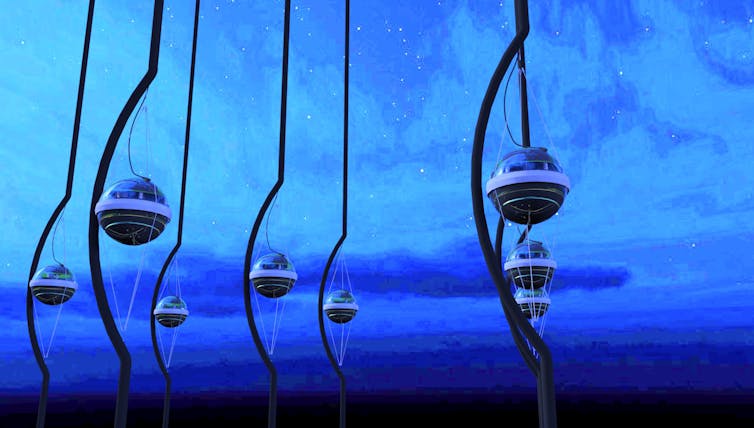
Catching nature’s slipperiest particles
With a complete detector, there is a clever trick that can be employed to filter out unwanted background particles and look for the few events we want to find – in this case, the presence of astrophysical neutrinos.
Instead of looking at all particles passing through the detector, the outer layers of IceCube are checked whenever enough light is made inside the detector.
Only neutrinos are able to sneak through the outer layers and create lots of light inside. If there is too much light on the boundary then the particle triggering the detector is probably a muon, and is discarded from our sample.
As a bonus, if an atmospheric neutrino with sufficient energy is made in the atmosphere above IceCube, we know that muons should be travelling along with the neutrino too. These muons should trigger the outer layers of IceCube, and again, the event will be discarded.
This makes looking for astrophysical neutrinos travelling down to the detector from above the surface our most viable channel – we believe that most of the events passing our filter are astrophysical.
When we analysed the data IceCube had collected, we found 28 events where we expected only 12 events from our backgrounds (muons that leak into the inner layers of the detector and atmospheric neutrinos unaccompanied by muons).
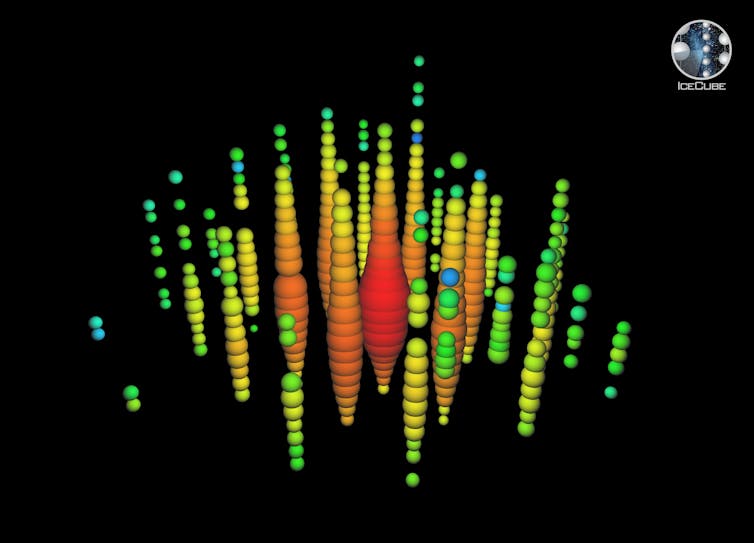
The 28 events are distributed with energies and angles that are consistent with what we might expect to see if we have a distribution of astrophysical sources, and are highly inconsistent with coming only from the atmosphere.
We are now confident we have begun to see astrophysical neutrinos, a very important development for the field of high energy astrophysics.
IceCube will continue to collect data for many years, and more neutrino experiments will continue to come online. We are rapidly reaching a point where we can solve the century-long mystery of the origin of cosmic rays.

